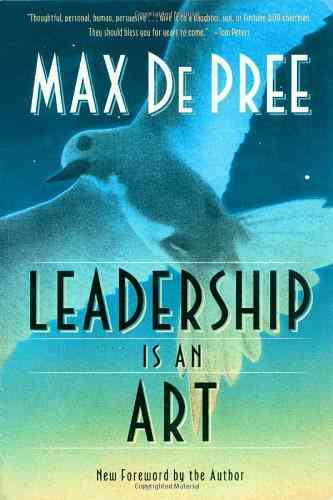
 Leadership Is an Art, by Max DePree. New York: Currency/Doubleday, 1987, 2004, 176 pp. ISBN 0-385-51246-5
Leadership Is an Art, by Max DePree. New York: Currency/Doubleday, 1987, 2004, 176 pp. ISBN 0-385-51246-5
Leadership Jazz, by Max DePree. New York: Bantam Doubleday Dell, 1992, 240 pp. ISBN 0-440-50518-6
Are administration and leadership synonymous? Not necessarily. Though often related, they are not one and the same. We have all seen people show leadership outside of an administrative post; conversely, there could be a competent administrator who is not a significant leader. What distinguishes administration from leadership? A primary distinction could be that the skills of administration concern "how to do," while those of leadership involve "how to be."
Be what? Max DePree, a noted model, teacher, and mentor in the art of leadership, addresses the central qualities of leadership in the two books reviewed here. Though his experience and examples arise out of the business world (he was the CEO of the Herman Miller Company, a prominent furniture company founded by his father and the place where he learned the foundations of leadership), his principles translate well into academe. In this brief review of his slim, wise, and widely acclaimed book, Leadership Is an Art, and its companion, Leadership Jazz, I intend to summarize (rather than to critique) his primary ideas with the hope of whetting others' appetites to read works which, for me, have provided an instructive and inspiring vision of the qualities of leadership.
Leadership, according to DePree, is not an easy subject to explain. It "is an art, something to be learned over time, not simply by reading books. Leadership is more tribal than scientific, more a weaving of relationships than an amassing of information, and in that sense," he writes, "I don't know how to pin it down in every detail."1 As a result, he presents no set of directions, no step-by-step methodology, no Ten Easy Tips. These are books about the inter-connection of ideas, beliefs, and relationships that have to do not with the "how" but with the "why" of leadership. In the broadest sense, leadership, according to DePree, is a quality of being, "an art, a belief, a condition of the heart,2 which begins with premises and ideas, rather than with practices and techniques.
Which premises? DePree discusses many qualities of leadership. Leaders have ideas. Leaders build community. Leaders listen. Leaders encourage contrary opinions. Leaders exercise stewardship, not ownership. Leaders have integrity, which he defines as the consonance of voice (what one says) and touch (what one does). However, the primary "why" or premise of leadership, a theme that permeates Leadership Is an Art, is to liberate people to do what is required of them in the most effective and humane way possible.3 The true leader enables his or her followers to realize their full potential by becoming their servant and by removing obstacles that interfere with their success. In the spirit of servant leadership, DePree reminds leaders that "the people who work with you are not your people; you are theirs."4 Leaders are not at the top or the center of an organization, he asserts; they are at its heart."5
The central purpose of leadership, maintains DePree, requires a number of important interconnected attributes and habits. First and foremost, a leader understands the diversity of people's gifts, talents, and skills. A leader not only accepts and values that diversity of ability, but also must polish, liberate, and enable those gifts. In fact, says DePree, a central quality of leadership is the ability to "abandon oneself to the strengths of others."6
It is this understanding, rather than the quest for efficiency, that forms the true foundation for the art of delegation. According to DePree, the art, as distinguished from the skill, of delegation is related to accepting and honoring the diversity of gifts. Delegation then becomes not a "dumping" or a shifting of workload, but a "gracious act of involvement;"7 it is related to the virtue of hospitality and helps people to reach their potential. It is not an easy quality to master; it requires giving up any notion that one must know or do everything oneself. Good delegation, writes DePree, involves surrendering ourselves to the gifts of others, a surrender that requires what DePree characterizes as a form of dying.8
According to DePree, leadership of this nature and quality both requires and nurtures a network of relationships in which community thrives. Like soloists in a jazz ensemble, he explains in Leadership Jazz, individual strengths are allowed and enabled to shine and even to lead, while "the leader" steps back. DePree believes the most effective contemporary management to be participative management, which, like playing in a jazz ensemble, is generated by and dependent on recognition of the various gifts people bring to the organization. He writes, "I believe that a large part of the secret [of leadership] lies in how individual leaders in a great variety of settings make room for people who have unusual and creative gifts and temporarily become followers themselves;"9 they become leaders of leaders. Participative management, DePree maintains, recognizes interdependence; it requires and builds community; it necessitates in the leader humility, magnanimity, and the knack for building and nurturing relationships.
If this suggests that leadership is fluid, DePree would say it is. The "leader" may be different people in different situations, and the leadership demonstrated is not necessarily encompassed in or restricted to job descriptions. Wise hierarchical leadership allows this temporary or roving leadership to be expressed in different ways and at different times, permitting others to share ownership of various situations. Such "roving" leadership flows out of a community of healthy relationships and aligns with one of DePree's central ideas, that the best leaders help people reach their potential.
Though given topical titles, the chapters in both books develop DePree's leadership principles in an evolving fashion. They are illustrated with many stories describing situations from which he learned about leadership - stories demonstrating the wisdom of others, from workers on a factory line to top designers in the furniture industry. DePree never presumes to have the only or last word; he presents himself as a fellow learner in the art of leadership. He offer lists of ideas and of questions for self-analysis, but always with the invitation to the reader to add and expand. "I have a few ideas," he writes. "Together with yours, we may have something."10
Regarding DePree's approach, reviewer Lewis Smedes writes, "Max DePree has a fine regard for his readers, which is in itself a splendid model for great leadership. He tells us much but not everything. He hints, he suggests, he nudges, he winks, caps a point with a fine story, and then trusts us to carry the ball for ourselves."11
His ball is worth catching. For growing in whatever leadership role you have or seek-with or without a title-I recommend these insightful books.
Endnotes
1 Leadership Is an Art, p. 3
2 Leadership Is an Art, p. 148
3 Leadership Is an Art, p. xxii
4 Leadership Jazz, p. 169-170
5 Leadership Jazz, p. 35
6 Leadership Is an Art, p. 9
7 Leadership Jazz, p. 153
8 Leadership Jazz, p. 157
9 Leadership Jazz, p. 94
10 Leadership Jazz, p. 192
11 Leadership Jazz, frontispiece


